ICU Management of Pediatric Asthma Exacerbation: A Case Study
VerifiedAdded on 2022/12/09
|7
|1904
|484
Case Study
AI Summary
This case study examines the presentation and management of a 10-year-old male, Peter, who was admitted to the ICU with an acute exacerbation of asthma. The analysis covers the pathogenesis of asthma, explaining the role of inflammation and bronchial hyper-responsiveness in Peter's respiratory symptoms. It discusses the importance of Fowler's position and oxygen delivery in managing respiratory distress. Furthermore, it delves into the pharmacological interventions, including the use of salbutamol via nebulizer, hydrocortisone IV, and ipratropium bromide via nebulizer, detailing their mechanisms of action, expected outcomes, and potential side effects. The case study underscores the critical aspects of diagnosing, managing, and preventing asthma exacerbations in pediatric patients, providing a comprehensive overview of the clinical approaches and treatments involved. Desklib offers a range of solved assignments and past papers for students seeking further assistance.

Short answer questions
Paraphrase This Document
Need a fresh take? Get an instant paraphrase of this document with our AI Paraphraser
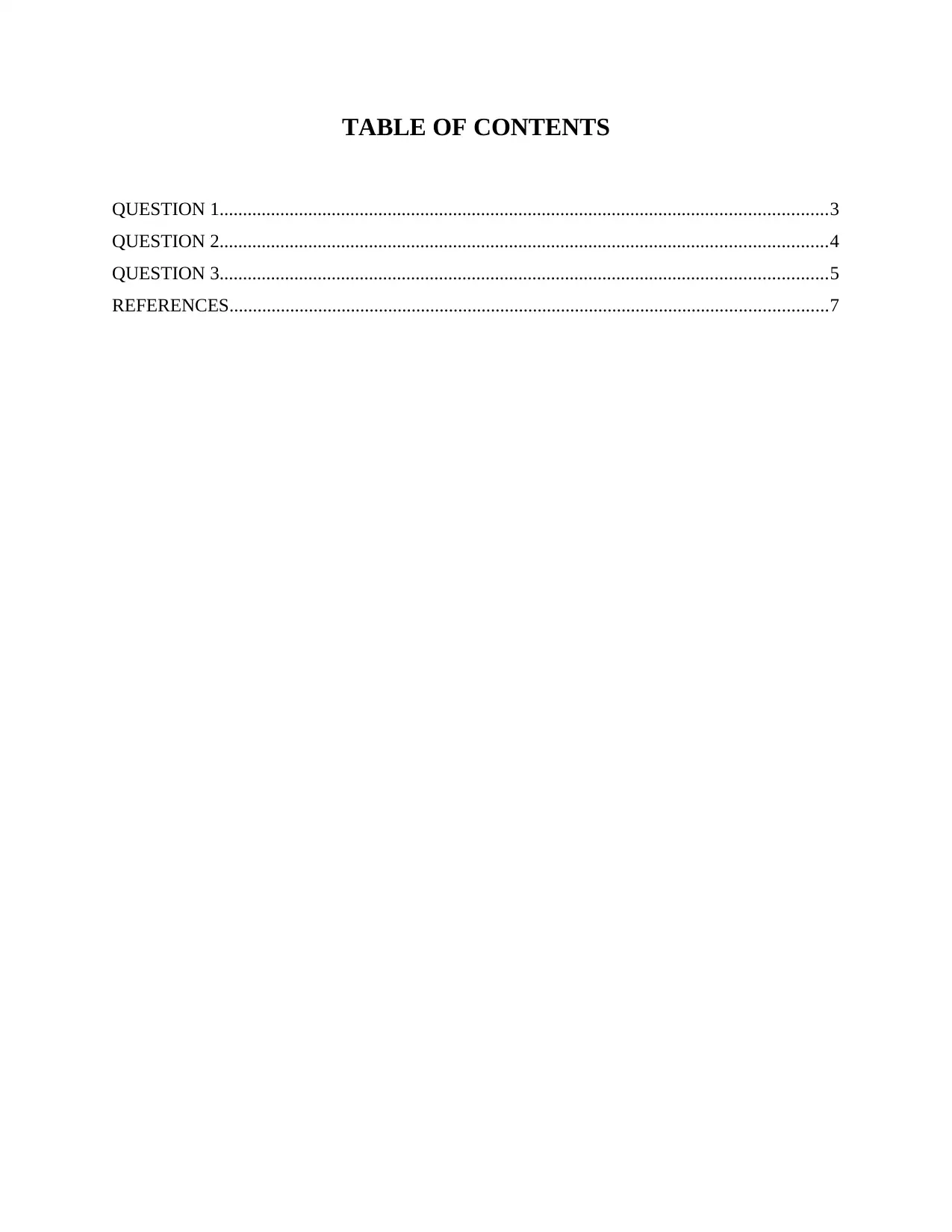
TABLE OF CONTENTS
QUESTION 1..................................................................................................................................3
QUESTION 2..................................................................................................................................4
QUESTION 3..................................................................................................................................5
REFERENCES................................................................................................................................7
QUESTION 1..................................................................................................................................3
QUESTION 2..................................................................................................................................4
QUESTION 3..................................................................................................................................5
REFERENCES................................................................................................................................7
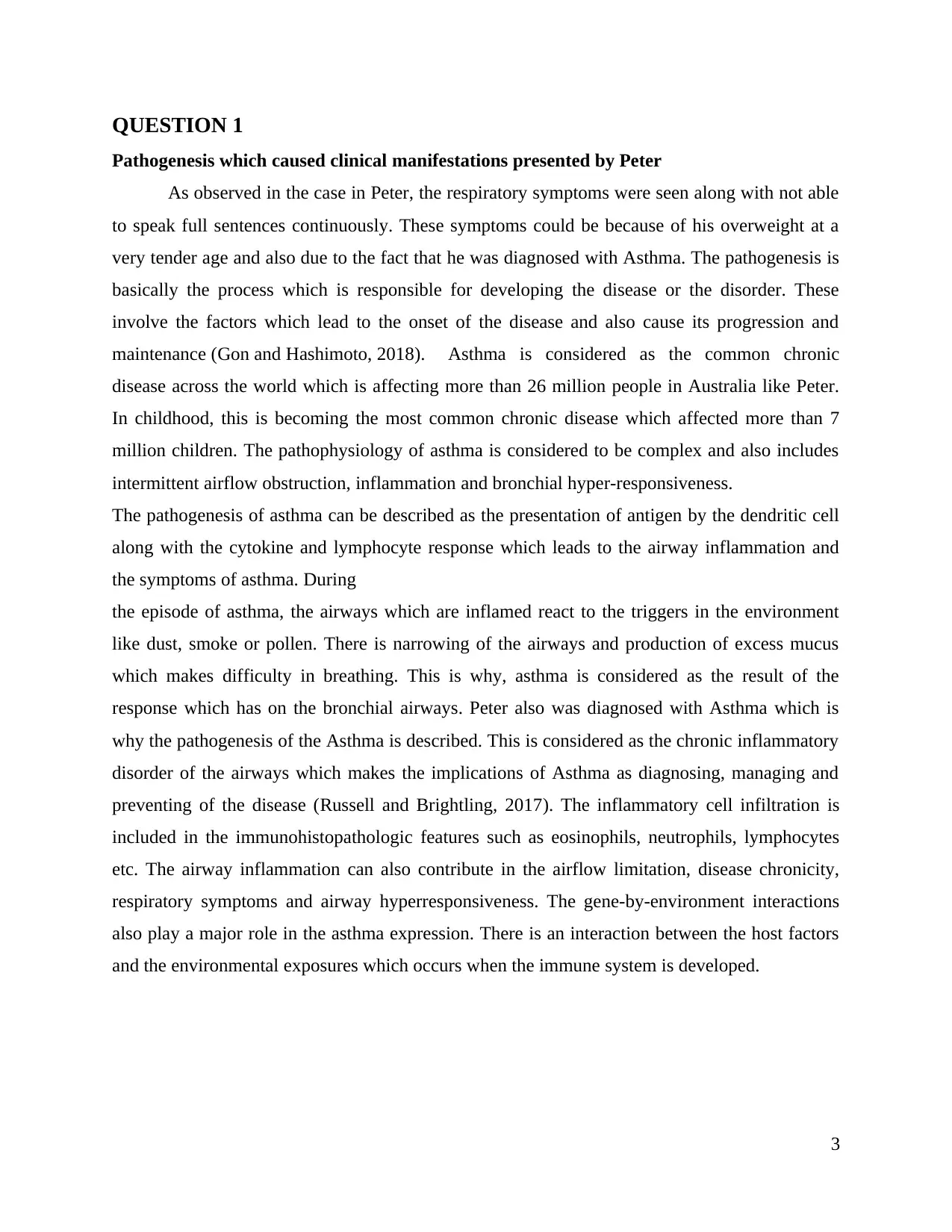
QUESTION 1
Pathogenesis which caused clinical manifestations presented by Peter
As observed in the case in Peter, the respiratory symptoms were seen along with not able
to speak full sentences continuously. These symptoms could be because of his overweight at a
very tender age and also due to the fact that he was diagnosed with Asthma. The pathogenesis is
basically the process which is responsible for developing the disease or the disorder. These
involve the factors which lead to the onset of the disease and also cause its progression and
maintenance (Gon and Hashimoto, 2018). Asthma is considered as the common chronic
disease across the world which is affecting more than 26 million people in Australia like Peter.
In childhood, this is becoming the most common chronic disease which affected more than 7
million children. The pathophysiology of asthma is considered to be complex and also includes
intermittent airflow obstruction, inflammation and bronchial hyper-responsiveness.
The pathogenesis of asthma can be described as the presentation of antigen by the dendritic cell
along with the cytokine and lymphocyte response which leads to the airway inflammation and
the symptoms of asthma. During
the episode of asthma, the airways which are inflamed react to the triggers in the environment
like dust, smoke or pollen. There is narrowing of the airways and production of excess mucus
which makes difficulty in breathing. This is why, asthma is considered as the result of the
response which has on the bronchial airways. Peter also was diagnosed with Asthma which is
why the pathogenesis of the Asthma is described. This is considered as the chronic inflammatory
disorder of the airways which makes the implications of Asthma as diagnosing, managing and
preventing of the disease (Russell and Brightling, 2017). The inflammatory cell infiltration is
included in the immunohistopathologic features such as eosinophils, neutrophils, lymphocytes
etc. The airway inflammation can also contribute in the airflow limitation, disease chronicity,
respiratory symptoms and airway hyperresponsiveness. The gene-by-environment interactions
also play a major role in the asthma expression. There is an interaction between the host factors
and the environmental exposures which occurs when the immune system is developed.
3
Pathogenesis which caused clinical manifestations presented by Peter
As observed in the case in Peter, the respiratory symptoms were seen along with not able
to speak full sentences continuously. These symptoms could be because of his overweight at a
very tender age and also due to the fact that he was diagnosed with Asthma. The pathogenesis is
basically the process which is responsible for developing the disease or the disorder. These
involve the factors which lead to the onset of the disease and also cause its progression and
maintenance (Gon and Hashimoto, 2018). Asthma is considered as the common chronic
disease across the world which is affecting more than 26 million people in Australia like Peter.
In childhood, this is becoming the most common chronic disease which affected more than 7
million children. The pathophysiology of asthma is considered to be complex and also includes
intermittent airflow obstruction, inflammation and bronchial hyper-responsiveness.
The pathogenesis of asthma can be described as the presentation of antigen by the dendritic cell
along with the cytokine and lymphocyte response which leads to the airway inflammation and
the symptoms of asthma. During
the episode of asthma, the airways which are inflamed react to the triggers in the environment
like dust, smoke or pollen. There is narrowing of the airways and production of excess mucus
which makes difficulty in breathing. This is why, asthma is considered as the result of the
response which has on the bronchial airways. Peter also was diagnosed with Asthma which is
why the pathogenesis of the Asthma is described. This is considered as the chronic inflammatory
disorder of the airways which makes the implications of Asthma as diagnosing, managing and
preventing of the disease (Russell and Brightling, 2017). The inflammatory cell infiltration is
included in the immunohistopathologic features such as eosinophils, neutrophils, lymphocytes
etc. The airway inflammation can also contribute in the airflow limitation, disease chronicity,
respiratory symptoms and airway hyperresponsiveness. The gene-by-environment interactions
also play a major role in the asthma expression. There is an interaction between the host factors
and the environmental exposures which occurs when the immune system is developed.
3
⊘ This is a preview!⊘
Do you want full access?
Subscribe today to unlock all pages.

Trusted by 1+ million students worldwide
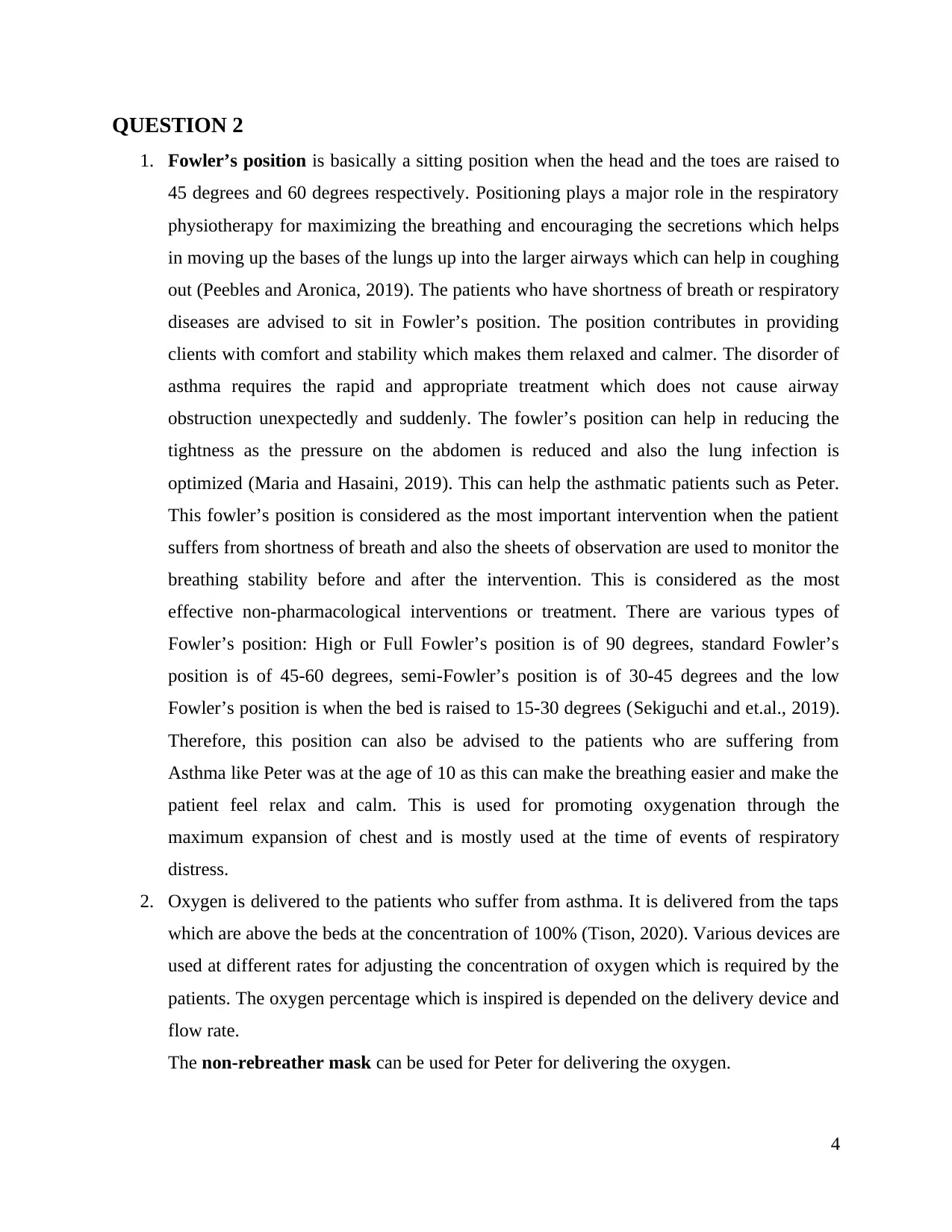
QUESTION 2
1. Fowler’s position is basically a sitting position when the head and the toes are raised to
45 degrees and 60 degrees respectively. Positioning plays a major role in the respiratory
physiotherapy for maximizing the breathing and encouraging the secretions which helps
in moving up the bases of the lungs up into the larger airways which can help in coughing
out (Peebles and Aronica, 2019). The patients who have shortness of breath or respiratory
diseases are advised to sit in Fowler’s position. The position contributes in providing
clients with comfort and stability which makes them relaxed and calmer. The disorder of
asthma requires the rapid and appropriate treatment which does not cause airway
obstruction unexpectedly and suddenly. The fowler’s position can help in reducing the
tightness as the pressure on the abdomen is reduced and also the lung infection is
optimized (Maria and Hasaini, 2019). This can help the asthmatic patients such as Peter.
This fowler’s position is considered as the most important intervention when the patient
suffers from shortness of breath and also the sheets of observation are used to monitor the
breathing stability before and after the intervention. This is considered as the most
effective non-pharmacological interventions or treatment. There are various types of
Fowler’s position: High or Full Fowler’s position is of 90 degrees, standard Fowler’s
position is of 45-60 degrees, semi-Fowler’s position is of 30-45 degrees and the low
Fowler’s position is when the bed is raised to 15-30 degrees (Sekiguchi and et.al., 2019).
Therefore, this position can also be advised to the patients who are suffering from
Asthma like Peter was at the age of 10 as this can make the breathing easier and make the
patient feel relax and calm. This is used for promoting oxygenation through the
maximum expansion of chest and is mostly used at the time of events of respiratory
distress.
2. Oxygen is delivered to the patients who suffer from asthma. It is delivered from the taps
which are above the beds at the concentration of 100% (Tison, 2020). Various devices are
used at different rates for adjusting the concentration of oxygen which is required by the
patients. The oxygen percentage which is inspired is depended on the delivery device and
flow rate.
The non-rebreather mask can be used for Peter for delivering the oxygen.
4
1. Fowler’s position is basically a sitting position when the head and the toes are raised to
45 degrees and 60 degrees respectively. Positioning plays a major role in the respiratory
physiotherapy for maximizing the breathing and encouraging the secretions which helps
in moving up the bases of the lungs up into the larger airways which can help in coughing
out (Peebles and Aronica, 2019). The patients who have shortness of breath or respiratory
diseases are advised to sit in Fowler’s position. The position contributes in providing
clients with comfort and stability which makes them relaxed and calmer. The disorder of
asthma requires the rapid and appropriate treatment which does not cause airway
obstruction unexpectedly and suddenly. The fowler’s position can help in reducing the
tightness as the pressure on the abdomen is reduced and also the lung infection is
optimized (Maria and Hasaini, 2019). This can help the asthmatic patients such as Peter.
This fowler’s position is considered as the most important intervention when the patient
suffers from shortness of breath and also the sheets of observation are used to monitor the
breathing stability before and after the intervention. This is considered as the most
effective non-pharmacological interventions or treatment. There are various types of
Fowler’s position: High or Full Fowler’s position is of 90 degrees, standard Fowler’s
position is of 45-60 degrees, semi-Fowler’s position is of 30-45 degrees and the low
Fowler’s position is when the bed is raised to 15-30 degrees (Sekiguchi and et.al., 2019).
Therefore, this position can also be advised to the patients who are suffering from
Asthma like Peter was at the age of 10 as this can make the breathing easier and make the
patient feel relax and calm. This is used for promoting oxygenation through the
maximum expansion of chest and is mostly used at the time of events of respiratory
distress.
2. Oxygen is delivered to the patients who suffer from asthma. It is delivered from the taps
which are above the beds at the concentration of 100% (Tison, 2020). Various devices are
used at different rates for adjusting the concentration of oxygen which is required by the
patients. The oxygen percentage which is inspired is depended on the delivery device and
flow rate.
The non-rebreather mask can be used for Peter for delivering the oxygen.
4
Paraphrase This Document
Need a fresh take? Get an instant paraphrase of this document with our AI Paraphraser
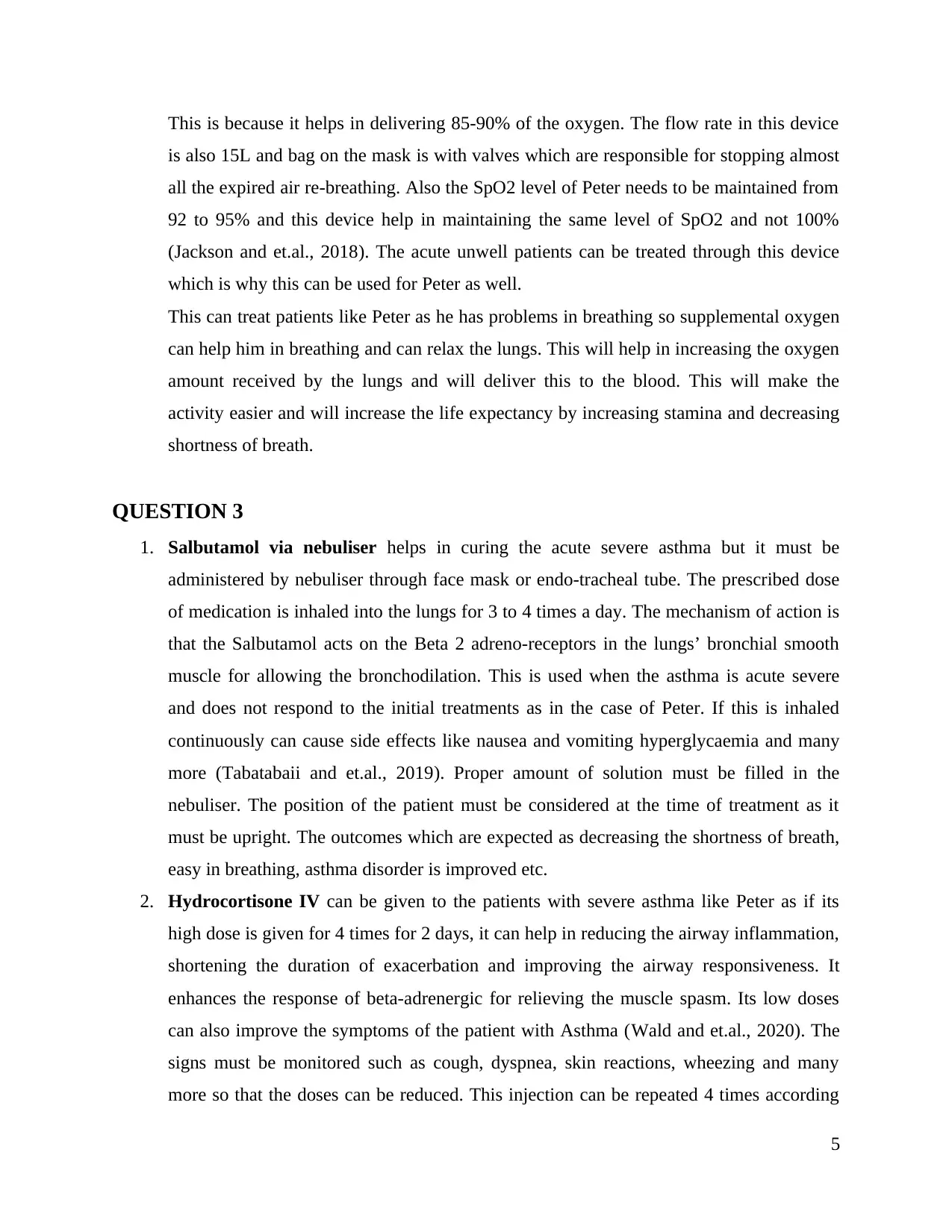
This is because it helps in delivering 85-90% of the oxygen. The flow rate in this device
is also 15L and bag on the mask is with valves which are responsible for stopping almost
all the expired air re-breathing. Also the SpO2 level of Peter needs to be maintained from
92 to 95% and this device help in maintaining the same level of SpO2 and not 100%
(Jackson and et.al., 2018). The acute unwell patients can be treated through this device
which is why this can be used for Peter as well.
This can treat patients like Peter as he has problems in breathing so supplemental oxygen
can help him in breathing and can relax the lungs. This will help in increasing the oxygen
amount received by the lungs and will deliver this to the blood. This will make the
activity easier and will increase the life expectancy by increasing stamina and decreasing
shortness of breath.
QUESTION 3
1. Salbutamol via nebuliser helps in curing the acute severe asthma but it must be
administered by nebuliser through face mask or endo-tracheal tube. The prescribed dose
of medication is inhaled into the lungs for 3 to 4 times a day. The mechanism of action is
that the Salbutamol acts on the Beta 2 adreno-receptors in the lungs’ bronchial smooth
muscle for allowing the bronchodilation. This is used when the asthma is acute severe
and does not respond to the initial treatments as in the case of Peter. If this is inhaled
continuously can cause side effects like nausea and vomiting hyperglycaemia and many
more (Tabatabaii and et.al., 2019). Proper amount of solution must be filled in the
nebuliser. The position of the patient must be considered at the time of treatment as it
must be upright. The outcomes which are expected as decreasing the shortness of breath,
easy in breathing, asthma disorder is improved etc.
2. Hydrocortisone IV can be given to the patients with severe asthma like Peter as if its
high dose is given for 4 times for 2 days, it can help in reducing the airway inflammation,
shortening the duration of exacerbation and improving the airway responsiveness. It
enhances the response of beta-adrenergic for relieving the muscle spasm. Its low doses
can also improve the symptoms of the patient with Asthma (Wald and et.al., 2020). The
signs must be monitored such as cough, dyspnea, skin reactions, wheezing and many
more so that the doses can be reduced. This injection can be repeated 4 times according
5
is also 15L and bag on the mask is with valves which are responsible for stopping almost
all the expired air re-breathing. Also the SpO2 level of Peter needs to be maintained from
92 to 95% and this device help in maintaining the same level of SpO2 and not 100%
(Jackson and et.al., 2018). The acute unwell patients can be treated through this device
which is why this can be used for Peter as well.
This can treat patients like Peter as he has problems in breathing so supplemental oxygen
can help him in breathing and can relax the lungs. This will help in increasing the oxygen
amount received by the lungs and will deliver this to the blood. This will make the
activity easier and will increase the life expectancy by increasing stamina and decreasing
shortness of breath.
QUESTION 3
1. Salbutamol via nebuliser helps in curing the acute severe asthma but it must be
administered by nebuliser through face mask or endo-tracheal tube. The prescribed dose
of medication is inhaled into the lungs for 3 to 4 times a day. The mechanism of action is
that the Salbutamol acts on the Beta 2 adreno-receptors in the lungs’ bronchial smooth
muscle for allowing the bronchodilation. This is used when the asthma is acute severe
and does not respond to the initial treatments as in the case of Peter. If this is inhaled
continuously can cause side effects like nausea and vomiting hyperglycaemia and many
more (Tabatabaii and et.al., 2019). Proper amount of solution must be filled in the
nebuliser. The position of the patient must be considered at the time of treatment as it
must be upright. The outcomes which are expected as decreasing the shortness of breath,
easy in breathing, asthma disorder is improved etc.
2. Hydrocortisone IV can be given to the patients with severe asthma like Peter as if its
high dose is given for 4 times for 2 days, it can help in reducing the airway inflammation,
shortening the duration of exacerbation and improving the airway responsiveness. It
enhances the response of beta-adrenergic for relieving the muscle spasm. Its low doses
can also improve the symptoms of the patient with Asthma (Wald and et.al., 2020). The
signs must be monitored such as cough, dyspnea, skin reactions, wheezing and many
more so that the doses can be reduced. This injection can be repeated 4 times according
5
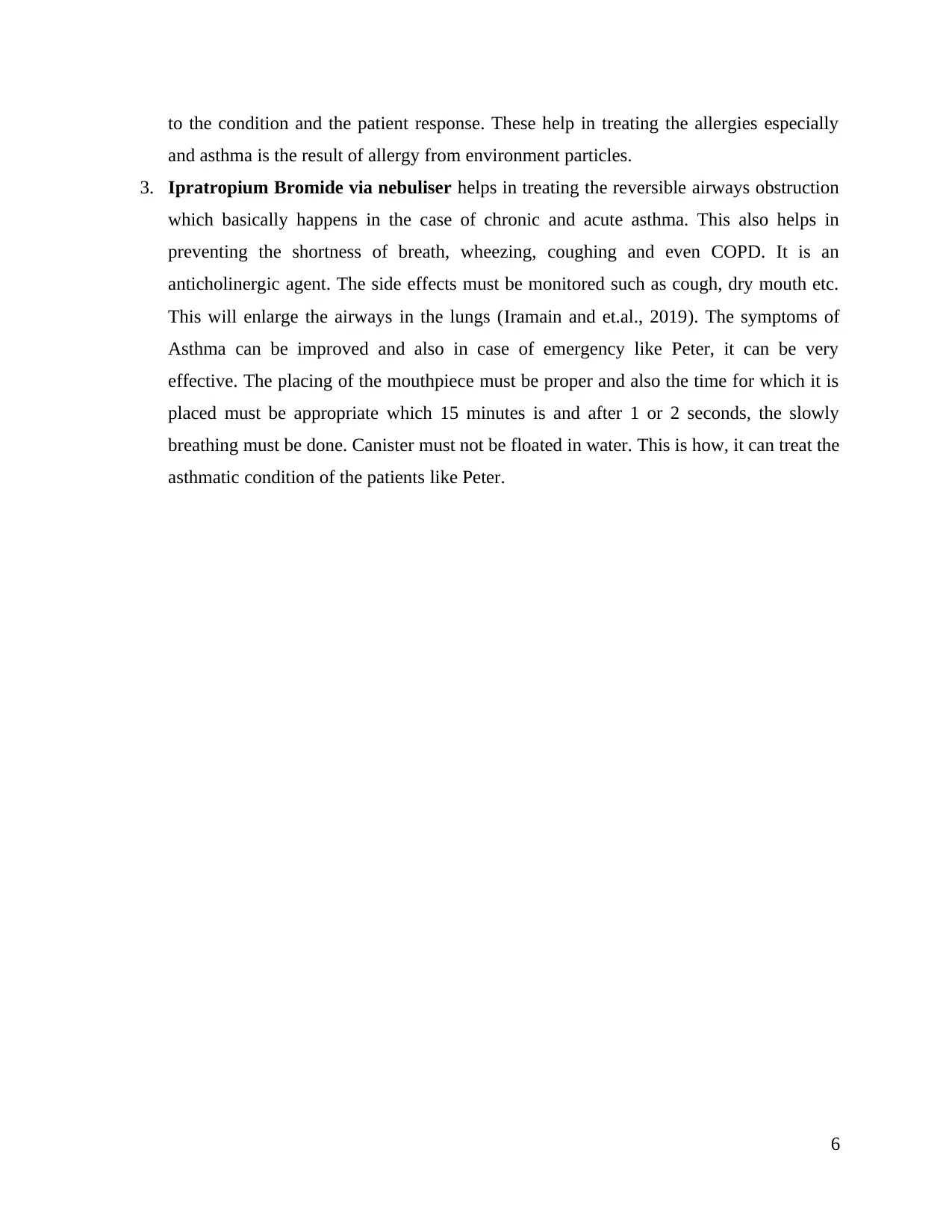
to the condition and the patient response. These help in treating the allergies especially
and asthma is the result of allergy from environment particles.
3. Ipratropium Bromide via nebuliser helps in treating the reversible airways obstruction
which basically happens in the case of chronic and acute asthma. This also helps in
preventing the shortness of breath, wheezing, coughing and even COPD. It is an
anticholinergic agent. The side effects must be monitored such as cough, dry mouth etc.
This will enlarge the airways in the lungs (Iramain and et.al., 2019). The symptoms of
Asthma can be improved and also in case of emergency like Peter, it can be very
effective. The placing of the mouthpiece must be proper and also the time for which it is
placed must be appropriate which 15 minutes is and after 1 or 2 seconds, the slowly
breathing must be done. Canister must not be floated in water. This is how, it can treat the
asthmatic condition of the patients like Peter.
6
and asthma is the result of allergy from environment particles.
3. Ipratropium Bromide via nebuliser helps in treating the reversible airways obstruction
which basically happens in the case of chronic and acute asthma. This also helps in
preventing the shortness of breath, wheezing, coughing and even COPD. It is an
anticholinergic agent. The side effects must be monitored such as cough, dry mouth etc.
This will enlarge the airways in the lungs (Iramain and et.al., 2019). The symptoms of
Asthma can be improved and also in case of emergency like Peter, it can be very
effective. The placing of the mouthpiece must be proper and also the time for which it is
placed must be appropriate which 15 minutes is and after 1 or 2 seconds, the slowly
breathing must be done. Canister must not be floated in water. This is how, it can treat the
asthmatic condition of the patients like Peter.
6
⊘ This is a preview!⊘
Do you want full access?
Subscribe today to unlock all pages.

Trusted by 1+ million students worldwide
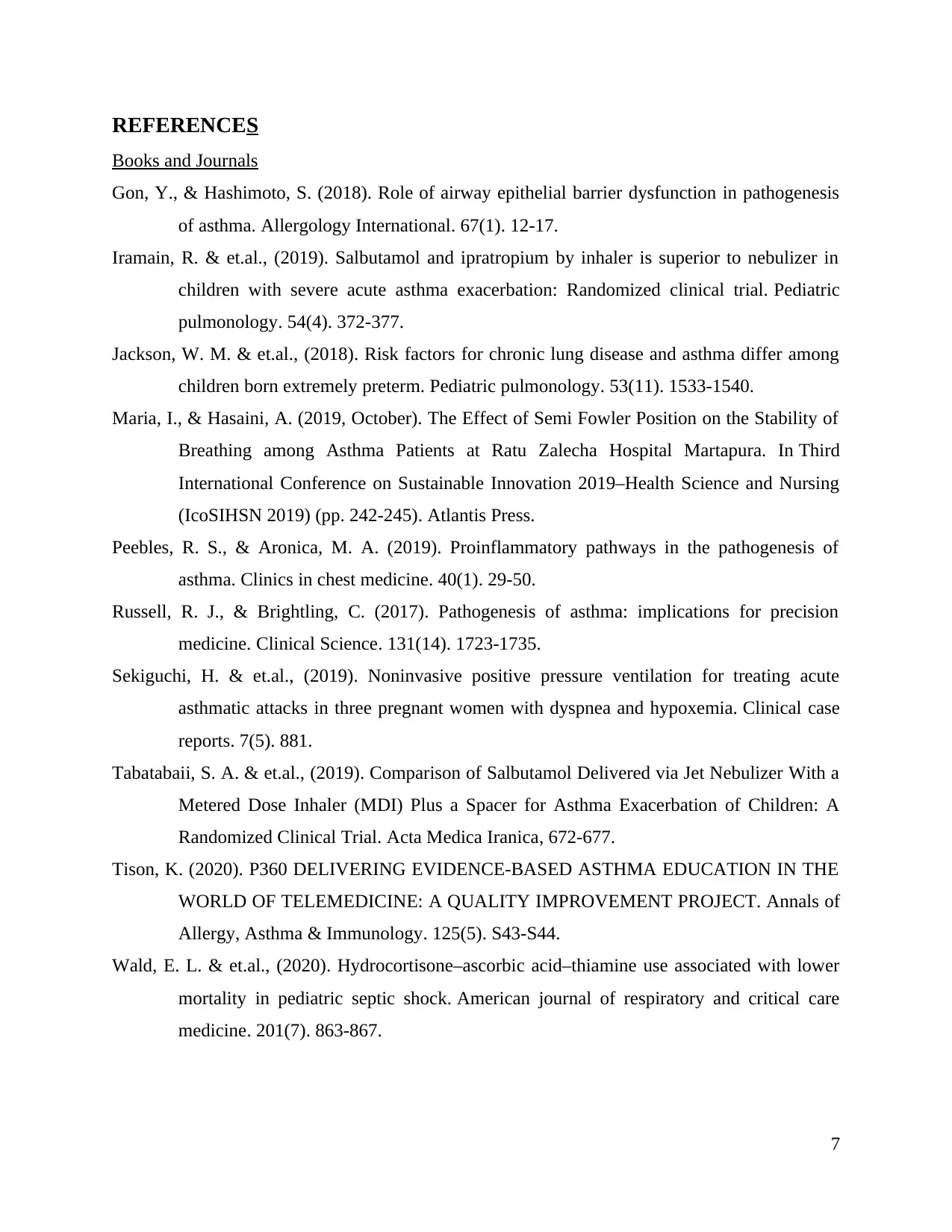
REFERENCES
Books and Journals
Gon, Y., & Hashimoto, S. (2018). Role of airway epithelial barrier dysfunction in pathogenesis
of asthma. Allergology International. 67(1). 12-17.
Iramain, R. & et.al., (2019). Salbutamol and ipratropium by inhaler is superior to nebulizer in
children with severe acute asthma exacerbation: Randomized clinical trial. Pediatric
pulmonology. 54(4). 372-377.
Jackson, W. M. & et.al., (2018). Risk factors for chronic lung disease and asthma differ among
children born extremely preterm. Pediatric pulmonology. 53(11). 1533-1540.
Maria, I., & Hasaini, A. (2019, October). The Effect of Semi Fowler Position on the Stability of
Breathing among Asthma Patients at Ratu Zalecha Hospital Martapura. In Third
International Conference on Sustainable Innovation 2019–Health Science and Nursing
(IcoSIHSN 2019) (pp. 242-245). Atlantis Press.
Peebles, R. S., & Aronica, M. A. (2019). Proinflammatory pathways in the pathogenesis of
asthma. Clinics in chest medicine. 40(1). 29-50.
Russell, R. J., & Brightling, C. (2017). Pathogenesis of asthma: implications for precision
medicine. Clinical Science. 131(14). 1723-1735.
Sekiguchi, H. & et.al., (2019). Noninvasive positive pressure ventilation for treating acute
asthmatic attacks in three pregnant women with dyspnea and hypoxemia. Clinical case
reports. 7(5). 881.
Tabatabaii, S. A. & et.al., (2019). Comparison of Salbutamol Delivered via Jet Nebulizer With a
Metered Dose Inhaler (MDI) Plus a Spacer for Asthma Exacerbation of Children: A
Randomized Clinical Trial. Acta Medica Iranica, 672-677.
Tison, K. (2020). P360 DELIVERING EVIDENCE-BASED ASTHMA EDUCATION IN THE
WORLD OF TELEMEDICINE: A QUALITY IMPROVEMENT PROJECT. Annals of
Allergy, Asthma & Immunology. 125(5). S43-S44.
Wald, E. L. & et.al., (2020). Hydrocortisone–ascorbic acid–thiamine use associated with lower
mortality in pediatric septic shock. American journal of respiratory and critical care
medicine. 201(7). 863-867.
7
Books and Journals
Gon, Y., & Hashimoto, S. (2018). Role of airway epithelial barrier dysfunction in pathogenesis
of asthma. Allergology International. 67(1). 12-17.
Iramain, R. & et.al., (2019). Salbutamol and ipratropium by inhaler is superior to nebulizer in
children with severe acute asthma exacerbation: Randomized clinical trial. Pediatric
pulmonology. 54(4). 372-377.
Jackson, W. M. & et.al., (2018). Risk factors for chronic lung disease and asthma differ among
children born extremely preterm. Pediatric pulmonology. 53(11). 1533-1540.
Maria, I., & Hasaini, A. (2019, October). The Effect of Semi Fowler Position on the Stability of
Breathing among Asthma Patients at Ratu Zalecha Hospital Martapura. In Third
International Conference on Sustainable Innovation 2019–Health Science and Nursing
(IcoSIHSN 2019) (pp. 242-245). Atlantis Press.
Peebles, R. S., & Aronica, M. A. (2019). Proinflammatory pathways in the pathogenesis of
asthma. Clinics in chest medicine. 40(1). 29-50.
Russell, R. J., & Brightling, C. (2017). Pathogenesis of asthma: implications for precision
medicine. Clinical Science. 131(14). 1723-1735.
Sekiguchi, H. & et.al., (2019). Noninvasive positive pressure ventilation for treating acute
asthmatic attacks in three pregnant women with dyspnea and hypoxemia. Clinical case
reports. 7(5). 881.
Tabatabaii, S. A. & et.al., (2019). Comparison of Salbutamol Delivered via Jet Nebulizer With a
Metered Dose Inhaler (MDI) Plus a Spacer for Asthma Exacerbation of Children: A
Randomized Clinical Trial. Acta Medica Iranica, 672-677.
Tison, K. (2020). P360 DELIVERING EVIDENCE-BASED ASTHMA EDUCATION IN THE
WORLD OF TELEMEDICINE: A QUALITY IMPROVEMENT PROJECT. Annals of
Allergy, Asthma & Immunology. 125(5). S43-S44.
Wald, E. L. & et.al., (2020). Hydrocortisone–ascorbic acid–thiamine use associated with lower
mortality in pediatric septic shock. American journal of respiratory and critical care
medicine. 201(7). 863-867.
7
1 out of 7
Related Documents
Your All-in-One AI-Powered Toolkit for Academic Success.
+13062052269
info@desklib.com
Available 24*7 on WhatsApp / Email
![[object Object]](/_next/static/media/star-bottom.7253800d.svg)
Unlock your academic potential
Copyright © 2020–2025 A2Z Services. All Rights Reserved. Developed and managed by ZUCOL.





